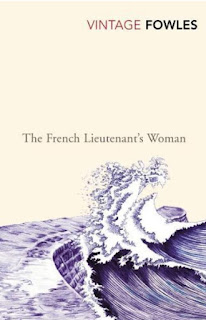French Lieutenant's Woman
I was curious to re-engage with French Lieutenant’s Woman,
having read the book at the age of eighteen and not since (closer to 1969, when
it was first published, than today). I remembered the novel in different ways
to how I experienced it afresh – perhaps the central romance struck me more
deeply then, or perhaps I appreciated the little writer-tricks more now.
Fowles draws us immediately into the coastal setting of
England’s Lyme Bay, where a provincial society is as close minded as the
forbidden nature is liberating. In the second chapter, the betrothed Charles
and Tina spy the mysterious figure dressed in black – the French Lieutenant’s
Woman – so-called because of a known liaison at a time when women of a certain
class kept their names intact at all costs. This allegedly fallen-woman is defiant, doubling before Charles with her, “unforgettable face, and a tragic face” (p. 10). From that moment, Charles is
smitten (though it will take him some time to admit to the fact).
Fowles' novel has been described as postmodern, and one
immediately notices that the narrator both draws us into the Victorian view,
and comments on it – so that we move between the world of fiction he
consciously evokes, and a more conventional literary world we inhabit. In
Chapter 13 Fowles (or his narrator) breaks free: ‘This story I am
telling is all imagination. These characters I create never existed outside my
own mind … I live in the age of Alain Robbe-Grillet and Roland Barthes; if this
is a novel, it cannot be a novel in the modern sense of the world’ (p. 95).
This chapter is an authorial meditation and largely we move back into the story
thereafter – until, famously, we come to an initial end (‘And so ends the
story’ [p. 340] where Sarah and Charles separate and Charles returns to his
senses, and an extended, alternative end – where Charles follows his heart,
suffers for it, and meets Sarah again in the future. It would be best not to
say more, but a story which branches is consistent with a story knowingly
invented, as if Fowles is merely a writer on a train, staring back at his
creation.
Towards the end, our narrator comments, ‘This river of life, of mysterious laws and mysterious choice, flows past a deserted embankment; and along that other deserted embankment Charles now begins to pace’ (p. 470).
I,
for one, pace with him.
Fowles leaves me thinking about how different the Victorian
mind is to our own, and yet also how all of us tell ourselves stories to
justify either adhering to convention (most of the time) or breaking free
(amorally, bravely, foolishly?). While solid Charles' uncertainty traverses the
ages, Sarah remains an enigma, for although her right to choose her fate may
appear at odds with the narrator’s god-like powers, she is something of an
artist herself. ‘The story you are telling is not only your imagination, but
mine’ – she might have said. Don’t leave me staring out at sea.




Comments
Post a Comment